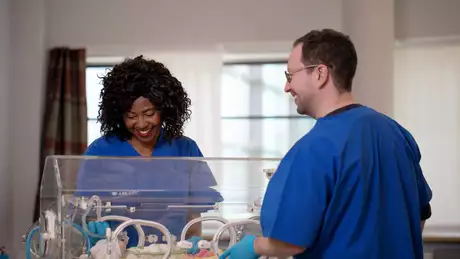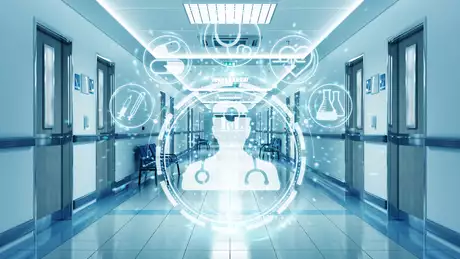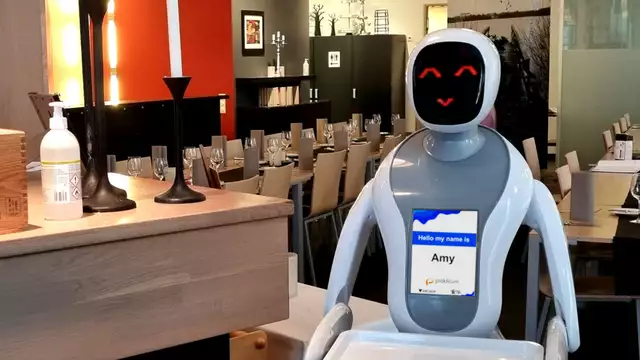
Waiter please! The capable service robots Amy and Alex
Published: 07.09.2023 / Publication / Blog / Artificial intelligence
In modern society we can find service robots deployed in various roles. The CASSIOPEIA research project has investigated the suitability of two service robots, Amy and Alex. The two robots have worked at the restaurant Prakticum, delivering food, desserts and appetisers. They have proven themselves to be quite capable, despite struggling to keep soup in a bowl. This blog post gives you the first reflective insights into our robot deployment study which we have been working on together with Prakticum.
Background
The small Starship delivery robots can be seen rolling around Helsinki as well as on the streets of Espoo. In Hietalahti at the Hampton Bay restaurant you can get served by a waiter robot. During two weeks in the spring of 2023, the research project CASSIOPEIA (soCial ASSIstive robOts dePloyEd in the service professIons) deployed humanoid service robots in a restaurant in Helsinki. CASSIOPEIA research group has studied the suitability of Arcada’s two service robots, named Amy and Alex of the CSJBOT line service robots (csjbot, 2020), in their role as waiters with focus on co-created use cases for the robots in a restaurant setting and striving to utilise the robots to their fullest capabilities. We’ve gained insights into what service professionals at the restaurant think of working together with robots.

Picture 1. Amy at restaurant Prakticum. (Photo Kristoffer Kuvaja Adolfsson)
From previous research and our own lab experiments we have seen how humans perceive and react to humanoid robots. In this project we focus on both restaurant professionals, i.e. co-workers, and customers as the end users. Research focusing on how the service professionals perceive and react to robots, especially in a robot-restaurant context, is a rarer topic. A focus on both clients and customers as well as co-workers is needed (Lu, Vinh, Wirz, Kunz, Paluch, Gruber, Martins & Patterson, 2019). In our project, we have put a lot of effort into the co-workers during the deployment at restaurant Prakticum, a practice restaurant for chef and waiter students. Involving the service professionals in the designing of the robots' tasks and training them to operate the robots has been insightful and relevant.
The Who and What of Amy and Alex
Robots are mechanical entities with sensors and computers that enable what we refer to as features (Futurelearn, 2013) and navigation was one such essential feature in our restaurant use case. To achieve autonomous navigation the robots use physical sensors (LiDAR) and advanced software (SLAM) to create a map of their environment. This then allows them to safely navigate and react to eventual obstacles. While map generation is mostly streamlined, map specifics need to be further processed by technicians and restaurant staff to be useful. For example, some days we only needed to label the tables correctly so that the robot would find its way. While on other days we needed to recreate the maps at short notice as tables got rearranged to accommodate large groups of customers. This is usability assessment and analysis research in practice!
Another feature of our humanoid robots is their appearance and their expressions. People tend to interact more and initiate interactions more frequently when interacting with a humanoid robot than with other types of robots. Embodied robots (robots with bodies) are indeed purposeful if people interact with them (Tung & Au, 2018; Nakanishi, Baba, Kuramoto, Ogawa, Yoshikawa & Ishiguro, 2020). When deploying humanoids, we also know that facial expressions and voice interaction are key features (Tung & Au, 2018), but in practice these features do not help us carry dirty dishes from a table to the kitchen after a meal. Here, the combination of navigation and interaction is what makes Amy and Alex special. They can carry different loads on their sturdy trays, and they offer simple interfaces on their touch screens for the restaurant personnel. A waiter can simply load up dirty dishes on the tray and send the robot back to the kitchen. These features are in line with research that shows that end-users (co-workers) would prefer a robot to take up dirty and dull tasks in a restaurant environment. (Seyitoglu et al, 2021).
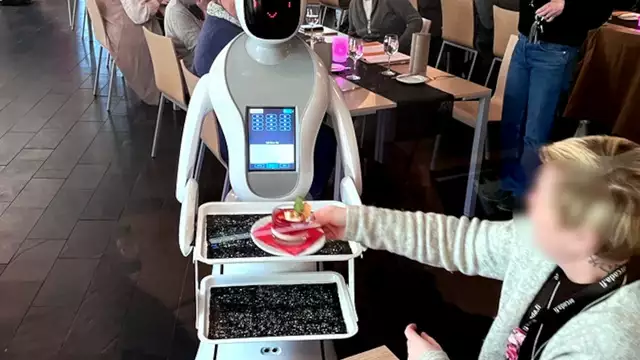
Picture 2. Amy serving a customer. (Photo Andrey Scherbakov-Parland)
From fast food to fine dining?
Specific types of restaurants are more suitable for deployment of humanoid service robots than others. In a fast-food restaurant where tasks and procedures are clearly defined and well-structured the robots see more success (Seyitoglu et al, 2021). However, some users perceive robots as threatening or hospitality reducing, both being detrimental to their user experience. Research also shows that AI deployment in restaurants can be seen as negative, especially in the case of luxury restaurants (Nozawa et al 2022). On the other hand, robots are efficient and hardworking and can also serve as an attraction, bringing visibility and people into a restaurant (Fuste-Forne, 2021). Restaurant Prakticum is not a fast-food restaurant. At Prakticum they serve a three-course meal every day and practice catering standards to the highest degree at every serving. Also, the restaurant is a training ground for aspiring chefs and waiters. These factors added a certain amount of complexity to the task for collaboration between service professionals (co-workers) and the humanoid robots.
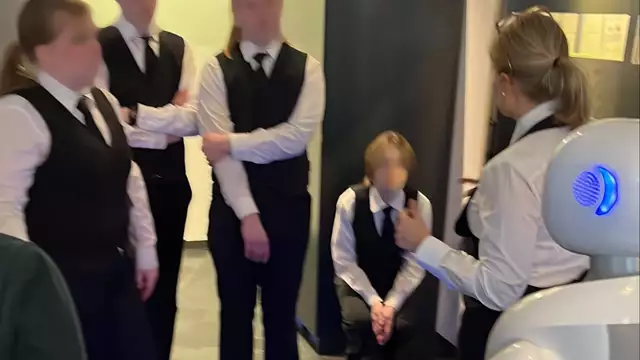
Picture 3. Amy is ready and the other waiters are given instructions. (Photo Andrey Scherbakov-Parland)
It is all about collaboration
Research says that robots work best in collaboration with humans, and it is important to get the employees on board. Robots are a complement and in their roles within the service sector features like emotions should be left to the human staff (Fuste-Forne, 2021). We followed recommendations set by research in our deployment, prepared the setting and trained the co-workers. This contributed to the success of the service and the usefulness of robots in our context. However, during the first days of our collaboration, we noticed some employees were not ready or willing to work with a robot.
When working with human robot interaction you can choose to focus on the feeling you want to create among the end users (Iwamoto et al, 2020). Amy and Alex proved flexible enough for our partners' needs with little things like choosing a logo for the display, playing the right music when serving, and changing the things that the robot said to the customers were of great benefit and elevated the atmosphere and feel of the service. Our co-workers at the Prakticum restaurant made many further suggestions on improvements for the robots; as an example, they wanted to be able to tap the shoulder of the robot so that it would turn around and face them. Another suggestion was to improve the carrying capacity, as the 5 kilos proved to be limiting when lifting plates of more than a kilo each. They also forbid the robot from soup delivery, as on its first attempt the robot Amy only managed to deliver a half empty bowl.

Picture 4. Amy and half a bowl of soup. (Photo Andrey Scherbakov-Parland)
Physical space was found to be a robot service research challenge due to Amy and Alex, both robots from Csjbot’s Humanoid Service Robot Waiter Amy line has a base width spanning 81 centimeters which meant that they required at least double their base width to avoid obstacles and make full 180 degree turns. In the restaurant this was a large factor to consider on a daily basis, as the restaurant rearranges tables based on the size of the arriving groups of customers.
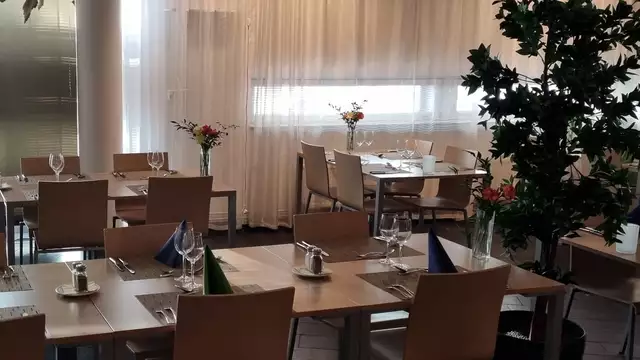
Picture 5. Restaurant Prakticum, a typical layout. (Photo Kristoffer Kuvaja Adolfsson)
At the end of the day
Research into humanoid robot deployment in the service sector is paradoxically broad yet limited and would benefit from conducting more longitudinal studies. This blog delivered insights from one use case and one practical implementation. Hence, a more in-depth analysis of our observations and the survey data collected will be published soon in a full report. And, we are interested in doing a follow-up study in a similar use case, hoping that the novelty effect among both co-workers and clients would have partially worn off, providing us with more valuable insights. We can see that for the robots to be able to act as a complement in a restaurant, the restaurant needs to be designed with service robots in mind. At the end of the day, we do agree that research attention is required looking into the clients’ and customers’ perceptions of humanoid service robots.
By Christa Tigerstedt, Dennis Biström and Kristoffer Kuvaja Adolfsson
References
Csjbot, 2020., “Humanoid Service Robot Waiter”, Accessed: 3.6.2023. Available:
https://en.csjbot.com/content/11/1298.html .
Futurelearn, 2013, “What makes a robot a robot?”. Accessed: 16.6.2023. Available: https://www.futurelearn.com/info/courses/robotic-future/0/steps/29367.
Fu, C., Liu, C., Toshinori Ishi, C., Yoshikawa, Y., Io, T. & Ishiguro, H. (2021). Using an Android Robot to Improve Social Connectedness by Sharing Recent Experiences of Group Members in Human-Robot Conversations. IEEE ROBOTICS AND AUTOMATION LETTERS, VOL. 6, NO. 4, OCTOBER 2021, pp 6670-6677. DOI 10.1109/LRA.2021.3094779
Fuste-Forne, F. (2021). Robot chefs in gastronomy tourism: What’s on the menu? Tourism Management Perspectives, 37.
Iwamoto, T., Baba, J., Nakanishi, J., Hyodo, K., Yoshikawa, Y. & Ishiguro, H. (2022)
Playful Recommendation: Sales Promotion That Robots Stimulate Pleasant Feelings Instead of Product Explanation. IEEE ROBOTICS AND AUTOMATION LETTERS, VOL. 7, NO. 4, OCTOBER 2022, pp. 11815-11822.
Lee, M.H. (2020). Developing Human friendly social AI. Massachuttes: MIT Press.
Lu, V.N., Wirtz, J., Kunz, W.H., Paluch S, Gruber, T, Martins, A. & Patterson P.G (2020). Impact of robots on customers and service employees. Journal of Service Theory and Practice. DOI 10.1108/JSTP-04-2019-0088
Nakanishi, J., Baba, J., Kuramoto I., Ogawa, K., Yoshikawa, Y. & Ishiguro, H. (2020). Smart Speaker vs. Social Robot in a Case of Hotel Room. IEEE/RSJ International Conference on Intelligent Robots and Systems (IROS). Proceedings, pp 11391-11396.
Nozawa, C., Togawa, T., Velasco, C. & Motoki, K. (2022). Consumer responses to the use of artificial intelligence in luxury and non-luxury restaurants. Food Quality and Preference, 96.
https://doi.org/10.1016/j.foodqual.2021.104436
Seyitoglu, F., Ivanov, S., Atsız, O., Çifçi, I. (2021). Robots as restaurant employees - A double-barrelled detective story. Technology in society, 67.
https://doi.org/10.1016/j.techsoc.2021.101779
Tung, V. & Au, N. (2018). Exploring customer experiences with robotics in hospitality. International Journal of contemporary hospitality management, vol 30, no 7, 2680-2697.

